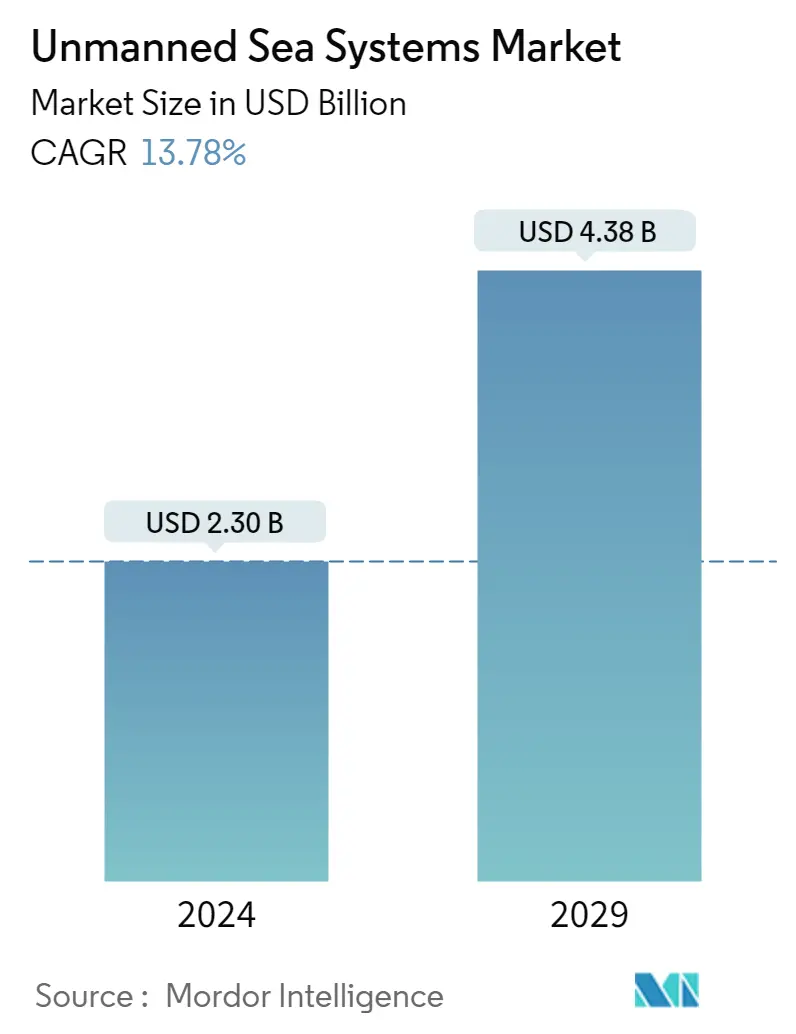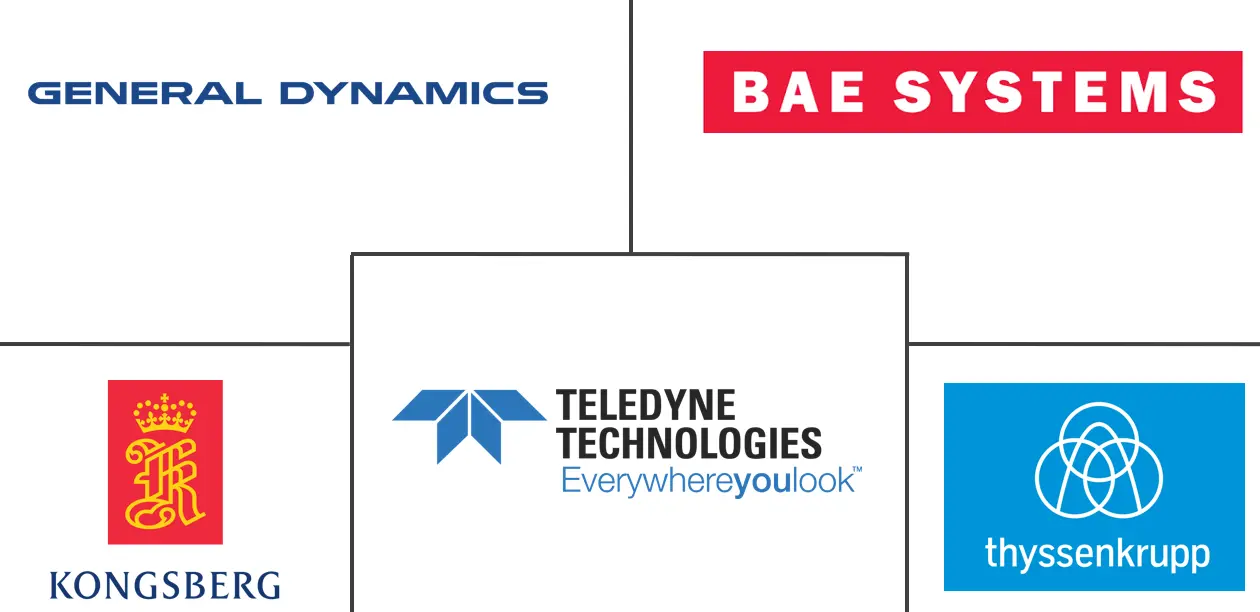Market Size of Unmanned Sea Systems Industry

| Study Period | 2019 - 2029 |
| Market Size (2024) | USD 2.30 Billion |
| Market Size (2029) | USD 4.38 Billion |
| CAGR (2024 - 2029) | 13.78 % |
| Fastest Growing Market | Asia-Pacific |
| Largest Market | North America |
| Market Concentration | Medium |
Major Players
*Disclaimer: Major Players sorted in no particular order |
Unmanned Sea System Market Analysis
The Unmanned Sea Systems Market size is estimated at USD 2.30 billion in 2024, and is expected to reach USD 4.38 billion by 2029, growing at a CAGR of 13.78% during the forecast period (2024-2029).
- With the growth in maritime tensions, several nations are investing huge amounts in enhancing their maritime surveillance and warfighting capabilities, supported by the growth in defense spending. Factors like the growth in defense spending, increasing focus on the development of sophisticated unmanned sea systems, and the growing adoption of unmanned vessels for various non-military applications are expected to drive the market growth. On the other hand, the technological challenges in the development of unmanned sea systems are projected to impact the market growth potential.
- The adoption of unmanned systems has also increased in various non-military or commercial sectors. They can be used for oceanography, hydrology research, scientific exploration, hydrographic surveys, emergency fire monitoring, control in oil rigs, and other tasks. Several players in the industry believe that autonomous shipping is the future of the maritime industry, which is presumed to supplement the growth of unmanned sea systems over the assessment period.
Unmanned Sea System Industry Segmentation
Unmanned sea systems are naval assets that can operate without a human occupant onboard the vessel.
The unmanned sea systems market is segmented based on type, capability, and geography. By type, the market is segmented into unmanned underwater vehicles (UUVs) and unmanned surface vehicles (USVs). By capability, the market is divided into remotely operated vehicles and autonomous vehicles. By application, the market is segmented into military, commercial, and other applications. Others include scientific and oceanographic research applications. The report also covers the market sizes and forecasts for the unmanned sea system market in major countries across different regions. For each segment, the market size is provided in terms of value (USD).
| Type | |
| Unmanned Underwater Vehicles (UUV) | |
| Unmanned Surface Vehicles (USV) |
| Capability | |
| Remotely Operated Vehicles | |
| Autonomous Vehicles |
| Application | |
| Military | |
| Commercial | |
| Other Applications |
| Geography | |||||||
| |||||||
| |||||||
| |||||||
| |||||||
|
Unmanned Sea Systems Market Size Summary
The unmanned sea systems market is poised for significant expansion, driven by increasing maritime tensions and the corresponding rise in defense spending. Nations are heavily investing in advanced maritime surveillance and warfighting capabilities, which is bolstering the demand for sophisticated unmanned sea systems. The market is also experiencing growth due to the expanding use of unmanned vessels in non-military applications such as oceanography, scientific exploration, and hydrographic surveys. Despite the promising growth trajectory, the market faces challenges related to technological advancements in unmanned systems. The industry is witnessing a shift towards autonomous shipping, which is expected to further propel market growth over the forecast period.
In the Asia-Pacific region, robust investments from countries like China, India, and Japan are anticipated to drive the highest growth in the unmanned sea systems market. These nations are focusing on developing advanced unmanned systems for defense and surveillance applications. The region is also seeing increased deployment of remotely operated and autonomous vehicles for commercial purposes, such as sea-bed mapping and surveying. The market is semi-consolidated, with key players like General Dynamics Corporation, Teledyne Technologies Incorporated, and Kongsberg Gruppen ASA holding significant shares. These companies are actively collaborating on developing autonomous features and advanced sensors to enhance operational efficiency. The market's growth is further supported by strategic investments and partnerships aimed at advancing unmanned sea system technologies.
Unmanned Sea Systems Market Size - Table of Contents
-
1. MARKET DYNAMICS
-
1.1 Market Overview
-
1.2 Market Drivers
-
1.3 Market Restraints
-
1.4 Porter's Five Forces Analysis
-
1.4.1 Bargaining Power of Buyers/Consumers
-
1.4.2 Bargaining Power of Suppliers
-
1.4.3 Threat of New Entrants
-
1.4.4 Threat of Substitute Products
-
1.4.5 Intensity of Competitive Rivalry
-
-
-
2. MARKET SEGMENTATION
-
2.1 Type
-
2.1.1 Unmanned Underwater Vehicles (UUV)
-
2.1.2 Unmanned Surface Vehicles (USV)
-
-
2.2 Capability
-
2.2.1 Remotely Operated Vehicles
-
2.2.2 Autonomous Vehicles
-
-
2.3 Application
-
2.3.1 Military
-
2.3.2 Commercial
-
2.3.3 Other Applications
-
-
2.4 Geography
-
2.4.1 North America
-
2.4.1.1 United States
-
2.4.1.2 Canada
-
-
2.4.2 Europe
-
2.4.2.1 United Kingdom
-
2.4.2.2 France
-
2.4.2.3 Germany
-
2.4.2.4 Russia
-
2.4.2.5 Rest of Europe
-
-
2.4.3 Asia-Pacific
-
2.4.3.1 China
-
2.4.3.2 Japan
-
2.4.3.3 India
-
2.4.3.4 South Korea
-
2.4.3.5 Rest of Asia-Pacific
-
-
2.4.4 Latin America
-
2.4.4.1 Brazil
-
2.4.4.2 Rest of Latin America
-
-
2.4.5 Middle East and Africa
-
2.4.5.1 United Arab Emirates
-
2.4.5.2 Saudi Arabia
-
2.4.5.3 South Africa
-
2.4.5.4 Rest of the Middle East and Africa
-
-
-
Unmanned Sea Systems Market Size FAQs
How big is the Unmanned Sea Systems Market?
The Unmanned Sea Systems Market size is expected to reach USD 2.30 billion in 2024 and grow at a CAGR of 13.78% to reach USD 4.38 billion by 2029.
What is the current Unmanned Sea Systems Market size?
In 2024, the Unmanned Sea Systems Market size is expected to reach USD 2.30 billion.

